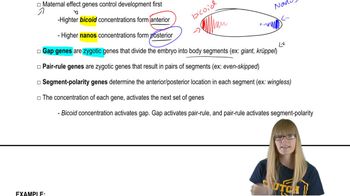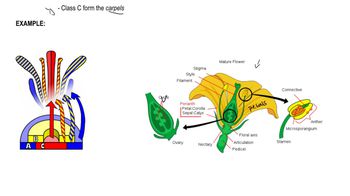Table of contents
- 1. Introduction to Genetics51m
- 2. Mendel's Laws of Inheritance3h 37m
- 3. Extensions to Mendelian Inheritance2h 41m
- 4. Genetic Mapping and Linkage2h 28m
- 5. Genetics of Bacteria and Viruses1h 21m
- 6. Chromosomal Variation1h 48m
- 7. DNA and Chromosome Structure56m
- 8. DNA Replication1h 10m
- 9. Mitosis and Meiosis1h 34m
- 10. Transcription1h 0m
- 11. Translation58m
- 12. Gene Regulation in Prokaryotes1h 19m
- 13. Gene Regulation in Eukaryotes44m
- 14. Genetic Control of Development44m
- 15. Genomes and Genomics1h 50m
- 16. Transposable Elements47m
- 17. Mutation, Repair, and Recombination1h 6m
- 18. Molecular Genetic Tools19m
- 19. Cancer Genetics29m
- 20. Quantitative Genetics1h 26m
- 21. Population Genetics50m
- 22. Evolutionary Genetics29m
14. Genetic Control of Development
Developmental Patterning Genes
Problem 3
Textbook Question
How is positional information provided along the anterior–posterior axis in Drosophila? What are the functions of bicoid and nanos?
 Verified step by step guidance
Verified step by step guidance1
<span>1. Understand the concept of positional information in Drosophila: Positional information refers to the spatial cues that help cells determine their location within an organism, guiding their development into specific structures. In Drosophila, this is crucial for establishing the anterior-posterior (head-to-tail) axis during embryogenesis.</span>
<span>2. Learn about maternal effect genes: These are genes whose products are deposited in the egg by the mother and are essential for early development. In Drosophila, two key maternal effect genes are bicoid and nanos, which play critical roles in establishing the anterior-posterior axis.</span>
<span>3. Explore the role of bicoid: Bicoid is a maternal effect gene that encodes a protein acting as a morphogen. It is deposited in the anterior part of the egg and forms a concentration gradient. High concentrations of bicoid protein at the anterior end activate genes necessary for head and thorax development.</span>
<span>4. Examine the function of nanos: Nanos is another maternal effect gene, but it is involved in posterior development. It is localized at the posterior end of the egg and inhibits the translation of hunchback mRNA, a gene that would otherwise promote anterior structures. This inhibition allows for the proper development of posterior structures.</span>
<span>5. Integrate the roles of bicoid and nanos: Together, bicoid and nanos establish a gradient of positional information along the anterior-posterior axis. Bicoid promotes anterior development, while nanos ensures posterior development by regulating the expression of other genes, thus providing a blueprint for the embryo's body plan.</span>
Recommended similar problem, with video answer:
 Verified Solution
Verified SolutionThis video solution was recommended by our tutors as helpful for the problem above
Video duration:
3mPlay a video:
Was this helpful?
Key Concepts
Here are the essential concepts you must grasp in order to answer the question correctly.
Positional Information in Development
Positional information refers to the spatial cues that guide the development of an organism, particularly during embryogenesis. In Drosophila, this information is crucial for establishing the anterior-posterior axis, which determines the head-to-tail orientation of the embryo. It is provided by gradients of specific morphogens that influence gene expression and cell fate.
Recommended video:
Guided course

Positional Cloning
Bicoid Protein
Bicoid is a key morphogen in Drosophila that is essential for anterior development. It is produced at the anterior end of the embryo and forms a concentration gradient, with higher levels at the front. Bicoid activates the expression of target genes that promote the formation of head structures, thus playing a critical role in establishing the anterior-posterior axis.
Recommended video:
Guided course

Proteins
Nanos Protein
Nanos is another important morphogen that functions primarily at the posterior end of the Drosophila embryo. It inhibits the translation of specific mRNAs, thereby regulating the development of posterior structures. Nanos works in conjunction with Bicoid to create a balance of positional information, ensuring proper segmentation and differentiation along the anterior-posterior axis.
Recommended video:
Guided course

Proteins

 11:19m
11:19mWatch next
Master Segmentation Genes with a bite sized video explanation from Kylia Goodner
Start learningRelated Videos
Related Practice



